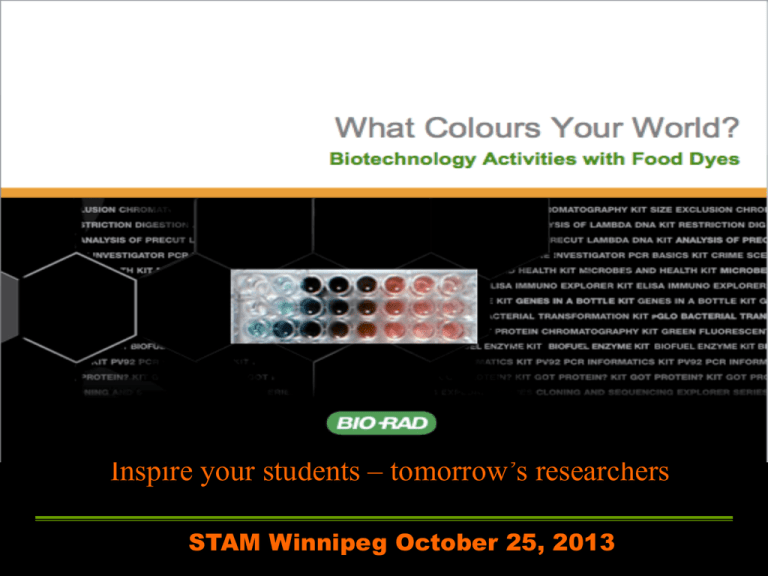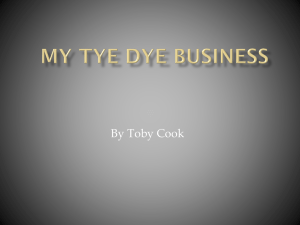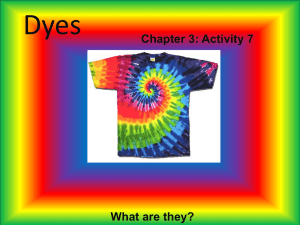stem-idea
advertisement

Inspire your students – tomorrow’s researchers STAM Winnipeg October 25, 2013 STEM Electrophoresis with Food Dyes Bio-Rad (Canada) Life Science Education – Biotechnology Explorer Consultant Robert Malyk BSc., MEd. Senior Biology Teacher (retired) Ridley College St. Catharines, ON Canada biobob4@hotmail.com Combining Science, Engineering and Math to Develop a Separation Technology Why Use Bio-Rad? • Real research!! • Guaranteed to work • Easy to prep • Cost Effective per student group • Easy, inexpensive first exposure to electrophoresis • Independent inquiry opportunities for what dyes are present in food items, what is the charge of the dyes, can they be separated based on charge/size? • Engineering inquiry with STEM kit ranging from optimizing metal composition and diameter for electrodes, gel matrix composition, buffer composition, etc. • Extensions including paper chromatography, spectroscopy, and researching food dyes commonly used Separation technology: How do you separate two or more compounds from each other? Electricity can be used to separate molecules by charge Sieves can be used to separate molecules by size Electrophoresis separates molecules by CHARGE and SIZE Electrophoresis means “to carry with electricity” Food dyes – Think about what you ate for breakfast or lunch… Did you eat any cheddar cheese? Was it orange? A Starbucks Strawberry Frapuccino? Food dyes – What flavor do you think this Skittle would have? Food dyes – We have been dying our foods for hundreds of years In the early 1800s some cheese and cayenne pepper was colored with LEAD tetroxide Pickles with COPPER sulfate Green tea with COPPER carbonate Food dyes – Canada Food Inspection Agency There was NO control or regulations on food dyes until the early 1900s Food dyes – Canada Food Inspection Agency Permitted Natural Colours in Canada and Corresponding European Names FD&C Dyes and Natural dyes FD&C FD&C FD&C FD&C FD&C FD&C FD&C FD&C Dyes Red 40 or FD&C Red 40 Lake Yellow 6 or FD&C Yellow 6 Lake Yellow 5 or FD&C Yellow 5 Lake Blue 1 or FD&C Blue 1 Lake Blue 2 or FD&C Blue 2 Lake Red 3 or FD&C Red 3 Lake Green 3 or FD&C Green 3 Lake Natural Dyes Carminic acid, carmine, or cochineal (from ground up beetle abdomens) Beetroot red or betanin (from beets) Curcumin (from tumeric) Caramel coloring (from sugar) Annatto (seeds of achiote trees) Lycopene (from tomatoes, watermelons, papayas, and red carrots) Food dyes in the news Food dyes have an intrinsic SIZE and CHARGE and therefore can be separated using Electrophoresis So how do we design an electrophoresis chamber to separate food dyes? Dye Electrophoresis Commercial versus built box comparisons What are some of the design factors we want to think about? Dye extraction from candies Building and running your electrophoresis system to separate the dyes Building and running your electrophoresis system to separate the dyes Building and running your electrophoresis system to separate the dyes Building and running your electrophoresis system to separate the dyes Building and running your electrophoresis system to separate the dyes Extensions Paper chromatography Spectroscopy Food diary Electrochemistry study pH changes at the cathode and anode Effect of material choice for electrode Optimization of STEM box system Electrode material choice and thickness Different materials for gel thickness Impact of TAE Concentration and Volume Gel percentages Copper electrode Gelatin matrix Other Activities Chromatography • Used to separate biomolecules based in their physical characteristics may include: • Size • Charge • Hydrophobicity • interaction with other molecules The System • All forms of chromatography have a –Stationary phase (remains stationary and is a solid or a liquid supported by a solid) –Mobile phase (a liquid or a gas that travels through the stationary phase and carries the parts of the mixture) Types of Chromatography • Paper –Paper serves as the stationary phase. –The paper strip is placed in a solvent (mobile) phase which carries the mixture through the paper. –Parts of the mixture will travel at different rates separating the parts • Column –The stationary phase is packed into a column –The column is equilibrated (saturated with solvent) –Sample is added to the column –Buffers are added to separate the mixture –Samples are collected in intervals called fractions Be an Engineer – Design your own! • Select materials that you will use to separate your Kool Aid into the food dyes that make it the color it appears • You will do this by –Paper chromatography –Column chromatography What are some of the design factors we want to think about? Dye separation from Kool Aid Using Paper Chromatography 1. Choose your paper type (stationary phase) 2. Cut it into .75 x 4 inch strips 3. Place 50ul of Kool-Aid at one end using a DPTP Dye separation from Kool Aid Using Paper Chromatography 4. Place 1 ml of your mobile phase into a medicine cup 5. Place the strip Kool-Aid side down into the mobile phase Building and Using A Column to Separate Your Kool-Aid 1. Choose your Column Type (HIC, Empty Column, Syringe) 2. If empty column or syringe add stationary phase by stuffing it with a cotton ball Building and Using A Column to Separate Your Kool-Aid 3. Choose your mobile phase (water, alcohol, or 1xPBS) 4. Place column in collection tube 5. Add 2 ml of mobile phase to column 6. Let it flow until it no longer drips Building and Using A Column to Separate Your Kool-Aid 7. Move column to next collection tube 8. Using a DPTP add 1ml of Kool-Aid to the top of the column 9. Let it flow until it no longer drips (this is fraction 1) 10. Move to the next column 11. Continue steps 5 and 6 until the eluate (fluid coming off the column) is clear Compare Results • Which paper, mobile phase worked best for paper chromatography? • Which column, mobile phase worked best for column chromatography?









